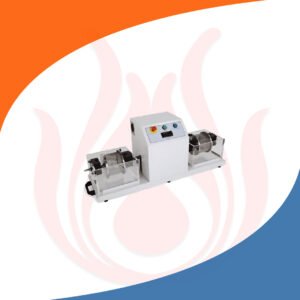Slake Durability
- High Quality Materials
- Compliance With Standards
- Clear Product Information
- Warranty & Support
- Product Testing & Certification
- Delivery & Policy
- Ask a Question
- Estimated Delivery: 5 Days – 10 Days
- DESCRIPTION
FEATURE | SPECIFICATION |
Mesh Diameter | 140mm |
Length | 100mm |
Motor Capacity | 20 R.P.M. |
Information About Slake Durability:
Slake durability is a test method used to assess the resistance of rocks, particularly those that are susceptible to weathering, to disintegration when subjected to cycles of wetting and drying. The test is primarily applied to sedimentary rocks, such as shales, mudstones, and some types of sandstones, which can degrade when exposed to moisture and environmental conditions over time. The slake durability test helps predict how these rocks will behave in natural settings, especially in construction projects, mining, and civil engineering.
Slake Durability Test (SDT) Overview:
Purpose:
- The test is designed to evaluate the durability of rocks by simulating natural weathering processes, specifically the repeated wetting and drying that rocks might experience in the field. It helps determine the rock’s ability to resist breakdown under these conditions.
Test Procedure:
- Sample Preparation:
- A sample of rock is prepared by breaking it into roughly spherical pieces, each weighing between 40 to 60 grams. Typically, 10 pieces are used for the test.
- Initial Weighing:
- The total mass of the rock pieces is measured before the test begins.
- Testing:
- The rock pieces are placed in a wire mesh drum with perforations. The drum is then submerged in water and rotated at a standard speed (usually 20 rpm) for a set period (usually 10 minutes), simulating one wetting cycle.
- Drying:
- After the first cycle, the drum is removed from the water, and the rock pieces are dried to a constant mass, usually in an oven.
- Second Cycle:
- The process is repeated, with the rocks undergoing a second cycle of wetting and drying.
- Final Weighing:
- After the second drying cycle, the rock pieces are weighed again.
- Sample Preparation:
Results:
- The durability of the rock is quantified by calculating the Slake Durability Index (SDI), which is expressed as a percentage:
- SDI = (Final Mass / Initial Mass) × 100%
- A high SDI (close to 100%) indicates that the rock is highly durable and resistant to weathering, while a low SDI indicates that the rock is less durable and more prone to disintegration.
Interpretation of Results:
- High Durability (SDI > 90%): Rocks that retain most of their mass after the test are considered highly durable.
- Moderate Durability (SDI between 75% and 90%): These rocks show some degradation but are still relatively durable.
- Low Durability (SDI < 75%): Rocks that lose a significant portion of their mass are considered less durable and more susceptible to weathering.
Applications:
- Geotechnical Engineering: The test helps engineers assess the suitability of rock for use in construction projects, such as foundations, embankments, and slopes, where weathering resistance is critical.
- Mining: In mining operations, the durability of rock affects both the stability of mine walls and the longevity of tailings and waste rock piles.
- Construction: In infrastructure projects, such as roads, bridges, and tunnels, the durability of the underlying rock formations is essential for long-term stability.
Advantages:
- Simplicity: The slake durability test is straightforward and requires relatively simple equipment.
- Relevance: It provides direct insight into how a rock will behave under natural environmental conditions, making it valuable for predicting long-term performance.
- Comparative Data: The test allows for easy comparison between different rock types or different samples from the same site.
Limitations:
- Specific to Certain Rock Types: The test is most applicable to sedimentary rocks and may not be as relevant for igneous or metamorphic rocks, which typically exhibit higher durability.
- Doesn’t Simulate All Weathering Processes: The test focuses on wetting and drying cycles but doesn’t account for other weathering processes like freeze-thaw cycles or chemical weathering.
The slake durability test is an essential tool for geotechnical engineers and geologists to evaluate the long-term stability and performance of rock materials under environmental conditions. do visit lotus traders.











